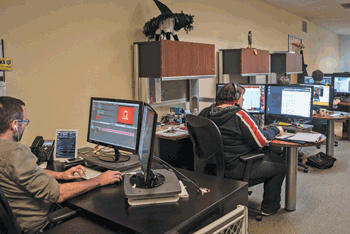Nathan Stahlman, the company’s vice president of product development, said e-learning is simply more effective. “Typically, when you look at the difference between time involved in a traditional learning environment and an electronic learning environment, it’s about two-to-one,” Stahlman explained.
A central reason for the effectiveness of e-learning, Stahlman noted, is interactivity.
“We are seeing more e-learning happening on touch devices,” he said. “What has traditionally been a visual and auditory experience can now include touch and motion… a third sensory input, which increases the transfer of learning as you’re making it truly multi-modal.”
At Vancouver-based Mocaworks, co-founder Mike Hunter discussed his company’s efforts to promote e-learning in the context of broader knowledge management systems for businesses.
Hunter said the advantage of e-learning is that it can happen anywhere at any time.
“Say I’m in the field, and I remember something from [an e-learning] course. I can pull out my phone or my iPad and I can search that term, and that piece of the course I’m looking for will come up. I can look at that small part of the course, refresh my learning, and apply it immediately,” he explained.
Stahlman agreed as to the value of flexibility in education, commenting that e-learning also allows training to be conducted on-demand, and can be done at work or at home.
In the process, Stahlman said, a company can realize significant savings in its training budget, eliminating “the lost revenue and down time you have from sending someone to a location to get trained, or bringing in an expert and housing them, and having that down time while training office staff.”
Corporate training
At Clark College Corporate Education, eLearning Instructional Designer Mark Gaither works with local companies to help them meet their training needs. Gaither explained that his organization produces entire online classes, often for companies seeking to upgrade employee skill sets and address specific work group requirements.
“The biggest advantage is that the person can do it in a time frame that fits their environment,” Gaither noted. “Most of what we’re trying to produce are self-paced learning activities.
“[For companies] it’s easy to track who has taken the training, when they took it and when they need to move to the next level of training,” he added.
Alternative education
For Instructional Technologies, experience in workplace training has led the company toward broader applications of electronic learning.
Stahlman described how the company has taken its expertise, and applied it to work with schools, pilot programs and various types of research and education.
Instructional Technologies is now working with a Tennessee school district to provide alternative education methods for at-risk children. For children who are not performing well in traditional educational environments, electronic methods can provide the means to real progress in learning.
These students, Stahlman said, “are using a combination of tactile and auto-narrated education… to allow them to still get the information without needing to have a literacy requirement. They can capture that knowledge while they are still working on their deficiencies.”
In Vancouver, at Advantage! Learning Solutions, local educator Lonnie Rae is pursuing some of the same objectives. Rae works with individuals of all ages who struggle with attention, memory, auditory and visual processing challenges.
“Advantage helps uncover the root issues, and uses technology, providing systematic exercise for the brain,” she explained.
Rae said that e-learning products currently constitute approximately 75 percent of her learning materials. She added that interactivity allows students to exercise more areas of the brain simultaneously, providing faster and more substantial results.
The future of e-learning
Among local e-learning experts, there is clear consensus that the future is mobile.
“We’re working with one company right now, a learning management development company, that has put together their own tablet system that’s proprietary with their material,” said Gaither. “It’s locked into their own material and you can’t use it to go anywhere else. That is great in a K-12 setting or in a professional business setting because if you want your employees to learn something, you just hand them the tablet and say, ‘take it home, check it out for a week and take these classes.’”
{jathumbnail off}









